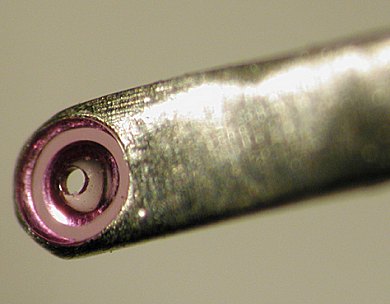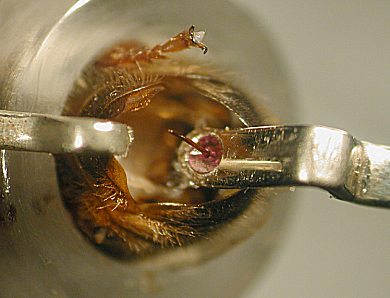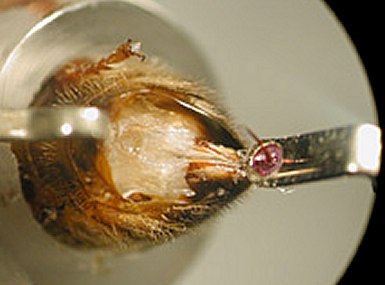Susan Cobey
Susan Cobey's Website
|
|
|---|
|
Susan Cobey Susan Cobey's Website |
Ruby Watch Bearing Jewel Used In Perforated Sting Hook |
|---|
|
Originally titled... "JEWELS FOR THE QUEEN," The New Ruby Jewel Sting Hook, Written by Susan Cobey, then of Ohio State University... Published as a webpage with her consent. A critical step in the instrumental insemination procedure is lifting the sting structure of the queen to expose the vaginal chamber. The new jeweled, perforated sting hook has a ruby insert. The tiny ruby ring of the hook is threaded to lift the sting during the insemination process. The design is based upon the perforated sting hook. With the appearance of fine jewelry, the ruby hook offers several practical advantages over the standard perforated hook. The ruby jewel is transparent, allowing the sting to be seen through the ruby, beneath the hook. The shape of the ruby, beveled on the underside of the jewel, guides the sting into the hole to more easily thread the sting. These two features make the ruby sting hook easier to use, especially for those just learning the procedure. |

|
|---|

|
Second to diamond, the ruby has a hardness rating of 9, giving it high durability. Over time, wear and the use of a fine cleaning wire can enlarge the hole of the standard perforated hook. Dried venom tends to clog the hole of the perforated hook with usage. A slight increase in the size of the hook hole, due to cleaning, can cause slippage of the sting during the insemination procedure. The hardness of the ruby maintains the specific 0.2 mm hole size necessary to securely grip the sting. |
|---|
|
The inset ruby ring is precisely and securely fitted in the hook, in the manner used to set stones in fine jewelry. The setting of the ruby eliminates the need for glue, which could be problematic with repeated exposure to saline and alcohol. The hook is made of German silver, it is non-corrosive, will not rust. Clean the hook with alcohol. Heat sterilization is not necessary. Editors Note... I originally credited Bill Samples with the prototype, but the original ruby sting hook, was the concept of and was designed and prototyped by Mark Jones, a jeweller and hobby beekeeper in Columbus, Ohio. He developed MS and was no longer able to make these items, Bill Samples took this on briefly, but Susan is now working with someone else and hopes to get these items back into production again soon. Bill Samples has some interesting items on his website, including many US patents about beekeeping. Printed from Dave Cushman's website Live CD version |

|
|---|
Transcribed from pdf... 06 November 2005, Addition... 12 December 2006, Upgraded and Corrected... 03 December 2007,
|